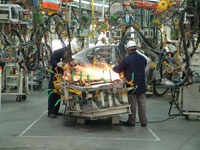
 Our U.S. economy depends on the flow of money to keep its engines running. Stop the flow and the engine chokes. To restart the engine requires priming and a larger than expected level of energy or more economic resources.
Our U.S. economy depends on the flow of money to keep its engines running. Stop the flow and the engine chokes. To restart the engine requires priming and a larger than expected level of energy or more economic resources.
The preceding analogy represents the extreme case. What our country is experiencing is an underperforming or slowed engine, not a stopped one.
So building momentum should be less of a challenge, correct?
Unlike an engine, an economy in sluggish motion exhibits friction and is impacted by human feedback. Friction retards movement and when coupled with contracting behavior leads to a further slowing of the economy. So it is not surprising that the Federal government has been pushing grant and loan funds into every existing channel as well as some new ones, in order to overwhelm the friction and constricting forces.
With so much money available, do we risk flooding the engine (i.e. the economy)? No, because the resources are phased, delivered through numerous varied channels and the uptake is self limiting.
What does all of this have to do with government loan programs and manufacturing companies? Government has and continues to view the manufacturing sector as the pivotal element around which the rest of the economy functions. So, it is a good place to start asking questions about the availability and utilization of government loan programs.
What distinguishes government loan tools from traditional debt financing?
Government loan tools are sourced using government funds such as Community Development Block Grant (Block Grant), USDA Rural Development, etc. and are used to further economic development activity. This type of financing, when compared to traditional bank loans, will typically have one or more of the following characteristics:
A lower qualification threshold (or conversely a higher capacity for risk absorption)
Targeted users
Subsidized interest rate
Loan terms that extend for a longer period of time
A forgivable component tied to project employment and investment goals
The time needed to process the loan
 Distribution of the loan tools is extensive. Loans can be obtained from Federal government agencies, State level financing authorities and even local municipalities or the chamber of commerce. The use is often dictated by the type of business, company annual revenues, location and level of funding required. But it is important to remember that the purpose of every government loan is to further economic development. So any manufacturing company giving consideration to pursuit of a government loan must articulate the use of the funds in the context of community impact and jobs – retained and created.
Distribution of the loan tools is extensive. Loans can be obtained from Federal government agencies, State level financing authorities and even local municipalities or the chamber of commerce. The use is often dictated by the type of business, company annual revenues, location and level of funding required. But it is important to remember that the purpose of every government loan is to further economic development. So any manufacturing company giving consideration to pursuit of a government loan must articulate the use of the funds in the context of community impact and jobs – retained and created.
USDA (United States Department of Agriculture) loans are part of the economic development program tools used by this federal agency in rural areas. No surprise here. Rural however, is generally defined by USDA as a community of 50,000 or less with the exception that smaller cities which are part of a large metropolitan community are excluded. More than one company has been surprised by this definition. Furthermore, eligible loan recipients can either be based in agriculture or not.
Federal Block Grant funds originate with HUD (Housing and Urban Development) and can be secured by a community for a specific economic development project. Block Grant funds come in grant and loan varieties. In the form of loan, the debt agreement is structured between the local or state administrative agent and the manufacturer. The manufacturer agrees to repay the loan according to preset terms. In some instances, the local municipality is allowed to retain the repaid funds and creates a secondary - revolving loan fund. Once set up, the need for the Federal source of Block Grants is theoretically diminished.
Not all sources of state and local loan funds come from the Federal government. A community may choose to create a loan fund by setting aside area specific taxes collected, e.g. food and beverage taxes. Once the fund is created, the eligibility requirements and the compliance obligations are defined, the loan fund can then be used like any other revolving loan fund. Other creative approaches to developing a loan fund include use of specialty taxes such as casino taxes.
Are the programs used? Credit has tightened significantly since the 3rd quarter of 2008. One would assume that government’s desire to see money flow and industry’s need for money would result in a rapidly growing symbiotic relationship. The potential exists. Reality is a different story.
Credit has tightened significantly since the 3rd quarter of 2008. One would assume that government’s desire to see money flow and industry’s need for money would result in a rapidly growing symbiotic relationship. The potential exists. Reality is a different story.
It is important to understand why the manufacturing sector has not been soaking up every available dollar in these programs especially when loan terms can be as favorable as zero interest, deferred principle payment for two to three years and a payback period of10 years. This question has perplexed our team for some time.
There are several reasons that surfaced from an anecdotal survey of community leaders, manufacturers and loan administrators. The remaining sections of this article will be used to describe what was informally learned through talking to these industry professionals, to present two case studies that demonstrate some of the points made and to make recommendations that could increase use. It should be noted that the points made are in no way a criticism of the programs or the companies rather an outgrowth from concern that under-utilization will handicap an economic turn around.
The first reason that loans are not used more extensively by manufacturers is they do not know about them nor do they know where to go to secure them. Several years of diminished demand for the loan tools has reduced the discussion and education about the tools which in turn has reduced demand. This is a marketing problem.
When the loan programs are presented, other challenges can surface. An incentive package that includes grants, tax credits, and training funds will also often include language about the availability of government loans. The three most common reasons that manufacturers do not incorporate a government loan tool into their project financing mix are: (1) they already have a sufficient line of credit with their lender, (2) their banking covenants preclude the company from incurring additional debt unless approved, or (3) the loan cannot provide the level of funding needed.
To secure a government loan requires the involvement of three parties – government, a company and the company’s lender – so a layer of complexity is added to the loan process. The complexity can show up in a number of ways including the time required to secure the loan, the need for a public approval process and environmental reviews. Timing seems to be the deterrent more often cited.
Case Study #1 A manufacturing operation located in the upper Central region of the United States decided that consolidation of three separate facilities into a single operation warranted serious evaluation. Management gathered the relevant project information, conducted a cost benefit analysis and concluded that a single 100,000+ square foot building at a new location was the best option.
A manufacturing operation located in the upper Central region of the United States decided that consolidation of three separate facilities into a single operation warranted serious evaluation. Management gathered the relevant project information, conducted a cost benefit analysis and concluded that a single 100,000+ square foot building at a new location was the best option.
During the site selection process, a commitment for economic assistance was secured from the state’s economic development authority, the county and the local municipality. Contained within the mix of incentives was a commitment for a low interest loan not to exceed $1.0 million from the county governmental agency. Management was not interested in securing the loan at first but later determined to pursue it. The change in attitude was due in part to loan document language that allowed a portion of the loan to be forgiven in the event certain project goals were met.
For reasons that remain unknown to this day, the county level agency withdrew its offer prior to loan closing after several months of work. In the absence of a loan, the project would have significantly changed and been delayed. The local community stepped up to do something unprecedented for them and replaced the loan with one from their community. Money was a critical factor to the project but time lost would have prevented success. Three months had been consumed in trying to get the first loan closed. Fortunately, the documentation and negotiations of the second loan were condensed by adopting the first loan’s agreement thus allowing the second loan to be approved and ready for closing within 30 days.
Case Study #2 A manufacturing operation located in a rural Southern community needed a rail spur to lower transportation costs of raw goods and finished products. The company had been evaluating a multimillion dollar investment in new equipment and plant modifications and determined the project could not proceed unless the rail spur became a reality.
A manufacturing operation located in a rural Southern community needed a rail spur to lower transportation costs of raw goods and finished products. The company had been evaluating a multimillion dollar investment in new equipment and plant modifications and determined the project could not proceed unless the rail spur became a reality.
The expansion project investment, job retention and job creation numbers were used to qualify the rail spur for economic assistance. Preliminary rail spur cost estimates ranged from $1.2 to $1.3 million depending upon the amount of soil compaction factored in. Funding commitments for the rail project were obtained from the state, the local community and the mainline rail company. The community was made aware of USDA loan tools and their potential for use in this project. The low interest loan program was pursued by the grant administrating agency on behalf of the community and the company. Submission delays caused the loan to be considered in a second round of funding and a start date that was six months later than originally anticipated. A review of rail project estimates by a second engineering firm increased the expected cost by a half million dollars. The unanticipated cost increase would have significantly altered the company’s equipment investment plans, so an alternative gap source was pursued. Ultimately, a second grant was secured from the State to cover the gap and the local community secured a loan from a consortium of community banks.
 A lack of knowledge about the government loan tools and understanding of program requirements caused some friction between parties when it could have enhanced the project.
A lack of knowledge about the government loan tools and understanding of program requirements caused some friction between parties when it could have enhanced the project.
Is increasing use feasible and effective?
The federal government allocates program funding to HUD, USDA and other government entities to enhance development activities of communities and business. If the core of the economy cannot engage these tools effectively, what do we need to do to promote use?
Let’s start with education and a dab of promotion. Then recognize that the customer, i.e., the loan recipient, has time pressures and needs to understand what constraints exist. Combine the preceding steps with clearly defined company expectations and accountability and program use will increase. What’s not to like about low cost money and a long payback period?

